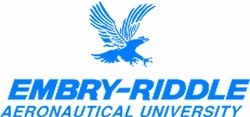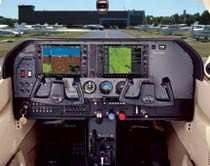Sun, Feb 05, 2006
 Embry-Riddle Aeronautical University
has purchased 16 high-tech Cessna 172 aircraft equipped with the
Garmin G-1000 glass cockpit suite and the industry-leading
automatic dependent surveillance broadcast (ADS-B) system. The
acquisition makes Embry-Riddle the nation’s only university
to combine the technically advanced aircraft cockpit suite and the
ADS-B collision-avoidance system in its training fleet.
Embry-Riddle Aeronautical University
has purchased 16 high-tech Cessna 172 aircraft equipped with the
Garmin G-1000 glass cockpit suite and the industry-leading
automatic dependent surveillance broadcast (ADS-B) system. The
acquisition makes Embry-Riddle the nation’s only university
to combine the technically advanced aircraft cockpit suite and the
ADS-B collision-avoidance system in its training fleet.
The large order also ensures that all students in
Embry-Riddle’s flight program will be able to pilot these
advanced aircraft during their flight training.
Embry-Riddle installed the FAA-standard ADS-B
collision-avoidance system in its fleet in 2003 because it provides
the extra margin of safety required for professional flight
training. A large multifunction panel in the aircraft’s
cockpit gives flight instructors and students real-time information
on potential air traffic threats.
“We believe the Cessna 172 equipped with both the glass
cockpit and ADS-B is the safest, most reliable, and most economical
way to teach advanced flight technology,” says Frank Ayers,
chair of the flight department at the university’s Daytona
Beach, Fla., campus.

The university is also adding the Garmin G-1000 glass cockpit to
its fleet of Frasca level-6 flight training devices to allow for a
more seamless transition between flight simulation and flight
training in its aircraft.
“This combination of glass cockpit simulation, on-board
collision avoidance, and technically advanced aircraft sets the
standard for collegiate aviation,” says Tim Brady, dean of
the College of Aviation at the campus.
Many of the new planes will be equipped with autopilots in order
to conduct special training in “technically advanced
aircraft,” a designation under the FAA Industry Training
Standards (FITS) program developed by Embry-Riddle researchers with
the aviation industry and other aviation-oriented academic
institutions. The FITS program creates scenario-based curriculums
aimed at preparing pilots to fly automated, high-performance
aircraft. Cessna Aircraft has adopted the FITS curriculums for its
own pilot-training program.
More News
Aero Linx: Model Aeronautical Association of Australia MAAA clubs are about fun flying, camaraderie and community. For over 75 years, the MAAA has been Australia’s largest fl>[...]
Touchdown Zone Lighting Two rows of transverse light bars located symmetrically about the runway centerline normally at 100 foot intervals. The basic system extends 3,000 feet alon>[...]
“Discovery and innovation are central to our mission at Virgin Galactic. We’re excited to build on our successful record of facilitating scientific experiments in subor>[...]
How To Get A Story On Aero-TV News/Feature Programming How do I submit a story idea or lead to Aero-TV? If you would like to submit a story idea or lead, please contact Jim Campbel>[...]
Student Pilot Reported That During Rotation, “All Of A Sudden The Back Of The Plane Kicked To The Right..." Analysis: The student pilot reported that during rotation, “>[...]
 ANN's Daily Aero-Linx (05.02.24)
ANN's Daily Aero-Linx (05.02.24) ANN's Daily Aero-Term (05.02.24): Touchdown Zone Lighting
ANN's Daily Aero-Term (05.02.24): Touchdown Zone Lighting Aero-News: Quote of the Day (05.02.24)
Aero-News: Quote of the Day (05.02.24) ANN FAQ: Contributing To Aero-TV
ANN FAQ: Contributing To Aero-TV NTSB Final Report: Cirrus Design Corp SR20
NTSB Final Report: Cirrus Design Corp SR20




